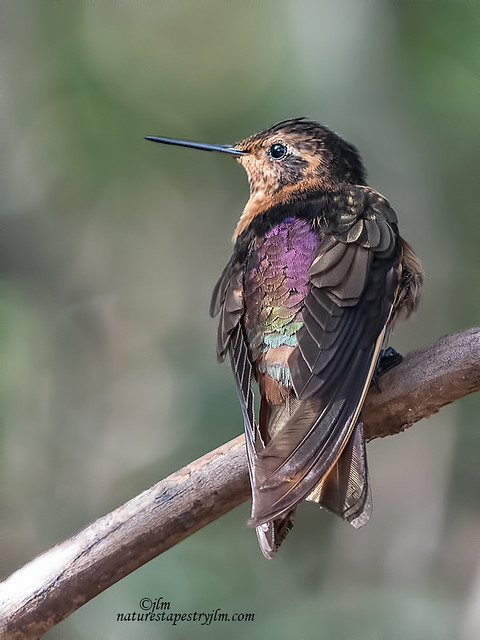#Aglaeactis cupripennis
Explore tagged Tumblr posts
Text
Hummingbird Species, Part 170
Our little flyer today is the shining sunbeam, Aglaeactis cupripennis. Introduction The natural world is a treasure trove of awe-inspiring creatures, each possessing unique qualities that contribute to the vibrant tapestry of biodiversity. Among these remarkable beings, the Shining Sunbeam Hummingbird (Aglaeactis cupripennis) stands out as a true marvel of avian evolution. This charismatic bird…

View On WordPress
#Aglaeactis cupripennis#hummingbird feeders for outdoors#Hummingbirds#hummingbirds of Central America#hummingbirds of South America#shining sunbeam#shining sunbeam hummingbird
0 notes
Text

Shining Sunbeam (Aglaeactis c. cupripennis), PUFFIN IT OUT!, family Trochilidae, order Apodiformes, Cuzco, Peru
photograph by JJ Pamplona
#sunbeam#hummingbird#aglaeactis#trochilidae#apodiformes#bird#ornithology#animals#nature#south america
2K notes
·
View notes
Text



[https://www.inaturalist.org/observations/37450923]
Shining Sunbeam || Aglaeactis cupripennis
Observed in Colombia
Least Concern in location of observation
#hummingbird#birds#nature#wildlife#photography#air beast#who cooks for queue? who cooks for queue all?#50
70 notes
·
View notes
Text

Shining sunbeam (Aglaeactis cupripennis) in Colombia
35 notes
·
View notes
Photo

Shining Sunbeam
120 notes
·
View notes
Video
Shining Sunbeam by Jay Packer Via Flickr: This large cinnamon-colored hummingbird of Colombia, Ecuador, and Peru is common in high elevation Andean cloud forests from about 8,000 to 14,000 feet. Unlike most hummingbirds, the color is on the back, presenting a unique challenge for photographers to capture a pose that shows the color but also the head. Hacienda El Bosque, Colombia
#Animalia#Amniota#Aves#Trochilidae (Hummingbirds)#Vertebrata#Archosauromorpha#Chordata#Tetrapoda#Apodiformes#Reptilia#South America#Shining Sunbeam#Diapsida#Colombia#Aglaeactis cupripennis#Animals#Birds#flickr
127 notes
·
View notes
Photo

Shining Sunbeam (Aglaeactis cupripennis)
© judylynn malloch
118 notes
·
View notes
Photo

Shining Sunbeam (Aglaeactis cupripennis)
© judylynn malloch
71 notes
·
View notes
Photo

A new variant has been added!
Shining Sunbeam (Aglaeactis cupripennis) © Christoph Moning
It hatches from arid, brown, dark, happy, high, iridescent, large, lilac, other, and short eggs.
squawkoverflow - the ultimate bird collecting game 🥚 hatch ❤️ collect 🤝 connect
9 notes
·
View notes
Photo

Shining Sunbeam (Aglaeactis cupripennis)
© Jory Teltser
87 notes
·
View notes
Video
Shining Sunbeam por Fernando Andrade Sánchez Por Flickr: Aglaeactis cupripennis Colibrí paramuno Bogotá - Colombia
8 notes
·
View notes
Text

Shining Sunbeam (Aglaeactis c. cupripennis), family Trochilidae, order Apodiformes, Manizales, Colombia
photograph by Charles J. Sharp
#sunbeam#hummingbird#aglaeactis#trochilidae#apodiformes#bird#ornithology#animals#nature#south america
608 notes
·
View notes
Text


[https://www.inaturalist.org/observations/143750279] Shining Sunbeam || Aglaeactis cupripennis Observed in Colombia Least Concern in location of observation
#hummingbird#birds#nature#wildlife#photography#air beast#who cooks for queue? who cooks for queue all?
17 notes
·
View notes
Text
Op is so extremely right but I need you guys how these actually look bc everything will make sense as soon as you see em
All images sourced from the Macaulay library.
Flame-Throated Sunangel (Heliangelus micraste)


Sparkling-Tailed Woodstar (Tilmatura dupontii)


Purple Crowned Fairy (Heliothryx barroti)


Shining Sunbeam (Aglaeactis cupripennis)


Sapphire Spangled Emerald (Chionomesa lactea)


(Continues on next two posts)
you learn about a hummingbird species named “flame-throated sunangel” or “sparkling-tailed woodstar” or “purple-crowned fairy” or “shining sunbeam” or “sapphire-spangled emerald” or “amethyst-throated sungem” (these are all real hummingbirds). and you think “all the superlative descriptions of hummingbirds must be exaggerations”. then you learn that this hummingbird has like magnificent luminous aquamarine or sparkling-gold or iridescent flaming-orange feathers on its back, or glittering throat patches with mesmerizing color transitions from deep purple to vibrant pink. and maybe its maximum size is smaller than a bumblebee, with an adult weight of 0.09 ounces (this is a real hummingbird). maybe it hovers in-place in mid-air and can beat its wings at 200 beats per second (this is a real hummingbird). maybe multiple flower species have essential mutualistic relationships with the birds. maybe there is an entire lineage of so-called “flower mites”, tiny arachnids that use hummingbirds to travel between plants and can only feed on specific flower nectar pollinated by hummingbirds (this is real). or maybe the species lives only very high on the slopes of a single mountain where its beak is specially customized to feed on the nectar of a single flower species (real). and maybe there are two dozen or more species of hummingbirds which only live in small isolated pockets of high-elevation fog-shrouded cloud forests in very specific humid microhabitats in the misty and forested peaks of the tropical Andes or Mesoamerica. where every mountain range’s special combination of mist and fog and flowers and nectar creates a home for a unique bird. maybe they love sugar, just like me. and you’re like “this can’t be real”.
25K notes
·
View notes
Video
instagram
Ecuador Hummingbird Trail: Antisana Wildlife Reserve. . . Antisana Wildlife Reserve has a amazing number of hummingbird species at different attitudinal gradients. . . We found a high altitude specie: Shinning Sunbeam (Aglaeactis cupripennis) . . #INaturalist #Crowdfunding #Cloudforest #Ecuador #Conservation #Nature #EcuadorRestoration #Travel #privatetours #wildlife #TravelMartLatinAmerica #TMLA #TMLA2019 #TravelEcuador #best #hummingbird #hummertrail #trail #photo #video #rg #ReGram #southamerica #explore #Andes (at Ecuador) https://www.instagram.com/p/Bz0UOg8gDji/?igshid=7h8r0kgsrz52
#inaturalist#crowdfunding#cloudforest#ecuador#conservation#nature#ecuadorrestoration#travel#privatetours#wildlife#travelmartlatinamerica#tmla#tmla2019#travelecuador#best#hummingbird#hummertrail#trail#photo#video#rg#regram#southamerica#explore#andes
0 notes
Video
Aglaeactis cupripennis / The Shining Sunbeam / Colibrí Paramuno by J. Esteban Berrío Via Flickr: Fotografía tomada en el PNN Los Nevados - Manizales, Caldas. The photo was taken in PNN Los Nevados - Manizales, Caldas. https://www.facebook.com/natureandbirdscolombia/
#J. Esteban Berrio#Pajaros#Pentax#Pentax k3#alados#aves de colombia#aves de suramerica#best birds#bird lovers#birding#birds#birds of south america#birds photography#birdwatching#colombia birds#colombia nature#fauna colombiana#fotografia de aves#fotografia salvaje#joe berrio#naturaleza colombiana#nature#nature loves#nature photography#nautre shot#pajareros#pajaros de colombia#plumas#south america birds#suramerican birds
16 notes
·
View notes
